SCULPTURE
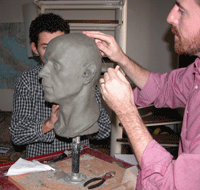 The
Sculpture programme provides a strong foundation for advanced projects in sculpture by developing craft skills. From a sound base of drawing, the program stresses the use of visual observation and structural elements to understand the complexities of form in space. Each student will receive individual tuition and group instruction. The
Sculpture programme provides a strong foundation for advanced projects in sculpture by developing craft skills. From a sound base of drawing, the program stresses the use of visual observation and structural elements to understand the complexities of form in space. Each student will receive individual tuition and group instruction.
Beginning students work from plaster casts in clay to develop strong observational skills. In the beginning students study the structure of the head, working from the human skull in clay and individual features of Michelangelo's David. This prepares them for sculpting from life. During the last lessons of each semester/program the students are expected to cast at least one piece in plaster and learn the waste mold or silicone mold making technique. Technical procedures include clay modeling, setting up an armature and casting techniques.
GO TO TOP
DRAWING
The aim of this programme is to develop an understanding of the human gesture, proportion, perspective, basic architectonic principles, anatomy, composition and quality of line. The objective of the first lessons is to draw the standing figure so that the students understand how to find the gesture line and skeletal structure of the composition in relationship to the plum line from the pit of the neck at the front and the seventh cervical vertebra at the back.
Another objective is to draw the figure concentrating on achieving an understanding of proportion using the seven and a half head figure schema as well as drawing the figure concentrating on achieving an understanding of architectonic mass relationships and rhythms.
GO TO TOP
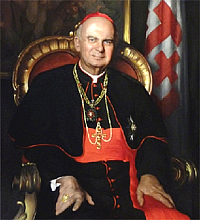 PAINTING PAINTING
This course will start with color and tonal theory as a foundational artistic vocabulary. This information will later be applied to working from figurative plaster casts with fixed lighting so as to learn how to manipulate tone and color to describe form is a controlled environment. Once this is achieved then the student will work on a live model in a portrait pose which will be followed by working from the full nude. Still life, drapery studies and multi figural compositions will also form part of this course.
GO TO TOP
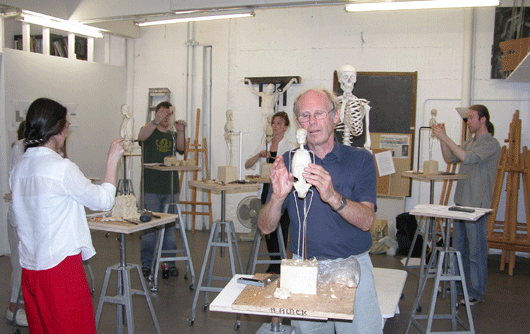 ARTISTIC
ANATOMY ARTISTIC
ANATOMY
This course is designed for those students that aspire to be fully competent figurative artists in whatever medium by developing a profound understanding of human anatomy that is crucial for creating convincing figurative art. The student will have achieved a total understanding of human anatomy as it relates to the subcutaneous form influencing bones, muscles, tendons, and fatty tissue. The use of "la Specola" Museum in Florence (www.flickr.com/photos/curiousexpeditions) will prove a great advantage in this course.
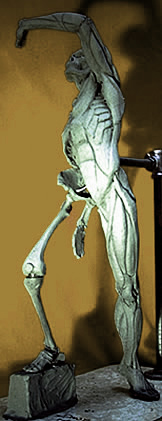 Artistic Anatomy I explores artistic anatomical vocabulary in 2D through drawing the skeleton and then drawing the Muscles on top with the use of transparent paper so as to see the origins and insertions of each muscle and how they overlap each other to influence the subcutaneous form. Artistic Anatomy I explores artistic anatomical vocabulary in 2D through drawing the skeleton and then drawing the Muscles on top with the use of transparent paper so as to see the origins and insertions of each muscle and how they overlap each other to influence the subcutaneous form.
Artistic Anatomy II explores artistic anatomical vocabulary in 3D through sculpting the skeleton and then applying each muscle from origin to insertion (Ecorche) so as to build on the knowledge of Artistic Anatomy I but this time conceiving it more profoundly as form in space.
Ecorche (french for removing skin), is an anatomical construction of a flayed figure, exposing the muscles for the purposes of study. Artists began human figure ecorche making during the Italian Renaissance. Students in this course will begin by sculpting an anatomically accurate skeleton (24”). Through the use of diagrams, Old Master drawings, specially prepared anatomical plaster casts, muscles will be attached according to their respective origins and insertions. The result will be a sculpture in its own right that reflects the subtle nuances and interactions between skeletal and muscular form based on artistic anatomy. Students can also make an ecorche study of head and arm at a larger scale for a detailed understanding of the anatomical structure of human form.
Aim: To develop a total artistic and anatomical understanding of the human form from the bones through the muscles to the fatty tissue to the skin in a 3D sculpture on an aluminium armature.
Artistic Anatomy II (a): to build the bone skeletal structure.
Artistic Anatomy II (b): to build the muscle structure over the bone structure so as to understand the origins and insertions of each muscle.
GO TO TOP
|
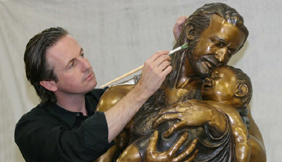
 The
Sculpture programme provides a strong foundation for advanced projects in sculpture by developing craft skills. From a sound base of drawing, the program stresses the use of visual observation and structural elements to understand the complexities of form in space. Each student will receive individual tuition and group instruction.
The
Sculpture programme provides a strong foundation for advanced projects in sculpture by developing craft skills. From a sound base of drawing, the program stresses the use of visual observation and structural elements to understand the complexities of form in space. Each student will receive individual tuition and group instruction. 


